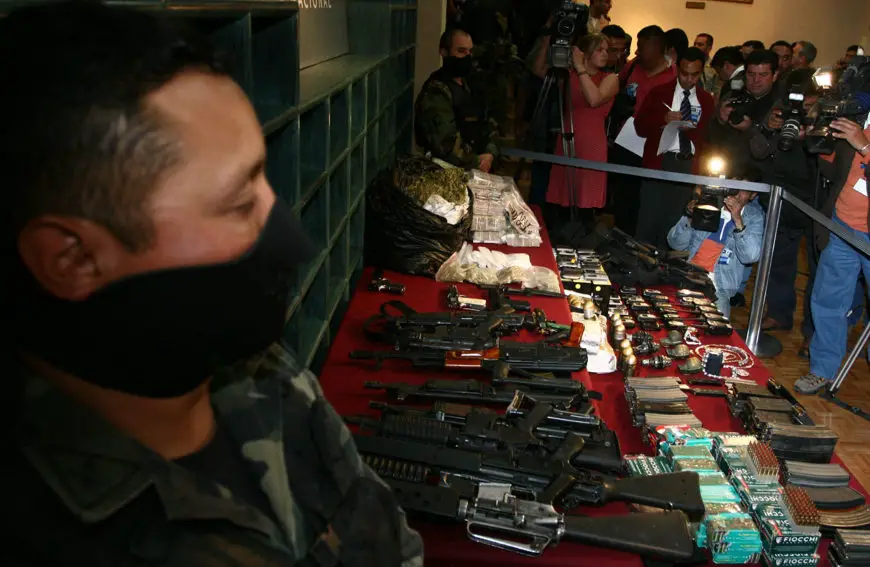Osiel Cárdenas Guillén, a former Gulf Cartel leader and founder of Los Zetas criminal organization, is now in prison in Mexico after he was deported from the United States on Monday.
The 57-year-old convicted drug trafficker was released from jail in the state of Indiana in August after his 25-year sentence was cut short for good behavior.

However, Cárdenas, nicknamed “El Mata Amigos” (The Friend Killer), didn’t become a free man as he was placed in the custody of United States Immigration and Customs Enforcement (ICE).
On Monday, he was “removed” to Mexico, “where he is wanted for homicide and illegal possession of a firearm,” ICE said in a statement.
“… Officers escorted Cárdenas via the San Diego Port of Entry where he was handed over to Mexican law enforcement without incident,” ICE said.
From Tijuana, the former Gulf Cartel leader was flown to Mexico City and subsequently transferred to the Altiplano federal maximum security prison in México state, according to the El Universal newspaper and other media organizations. He reportedly arrived at the facility from which Joaquín “El Chapo” Guzmán escaped in 2015 in the late afternoon on Monday.
Cárdenas is accused of a range of offenses, including homicide, drug trafficking, involvement in organized crime, weapon possession, bribery and the use of resources of illicit origin.
El Universal reported that he could be sentenced to up to 730 years in jail if convicted on all charges. The newspaper said that seven federal criminal prosecutions against Cárdenas will be reactivated now that he is in custody in Mexico.

Cárdenas, once head of a ‘mammoth’ drug empire, has spent much of his adult life behind bars
Cárdenas, a native of the northern border state of Tamaulipas, was once considered one of Mexico’s most powerful drug lords. Unlike some other Mexican cartel kingpins, he wasn’t so successful in evading the long arm of the law.
In August 1992, aged 25 at the time, Cárdenas crossed into Brownsville, Texas, from his native Matamoros and was arrested the same day “for possessing with intent to distribute, approximately two kilograms of cocaine,” ICE said on Monday.
In early 1993 he was convicted of cocaine possession with intent to distribute and was sentenced to 63 months in jail. At the end of 1993, Cárdenas was “transferred to Mexico under the Treaty between the United States and Mexico on the Execution of Penal Sentences,” ICE said.
By the mid 1990s, Cárdenas was out of jail and free to resume his criminal career. He soon became the top leader of the Gulf Cartel (CDG).
During his 1997-2003 leadership of the cartel, “the CDG controlled a mammoth cocaine and marijuana trafficking empire that rivaled those of other storied Mexican organized crime groups, including the Sinaloa Cartel,” according to Insight Crime, a think tank and media organization that focuses on organized crime in the Americas.
Cárdenas was arrested in Tamaulipas in 2003, extradited to the United States in 2007 and in March 2010, he was convicted in a federal court in Houston on drug trafficking and money laundering charges as well as “threatening to assault and murder a federal agent,” according to ICE. He served 14 years of his 25-year sentence.
While leader of the CDG, Cárdenas created Los Zetas in the late 1990s. Los Zetas served as the Gulf Cartel’s armed enforcer wing until it struck out on its own in 2010. The group initially consisted of deserters from an elite unit of the Mexican army.
Los Zetas “professionalized Mexico’s gangland warfare by detonating an arms race and introducing a kind of brutal violence never before seen in the country,” Insight Crime reported earlier this year.
In 2010, Los Zetas murdered 72 migrants — 58 men and 14 women — in the municipality of San Fernando, Tamaulipas.

Michael Deibert, a journalist and author who wrote a book about the Gulf Cartel, told Insight Crime that Cárdenas is “arguably the most impactful, though not most famous, narco leader in Mexico.”
Mike Vigil, former head of international operations for the DEA, said earlier this year that he was an “architect of extreme violence” and “his methods have become the blueprint for other cartels in Mexico.”
With reports from El Universal and UNO TV
